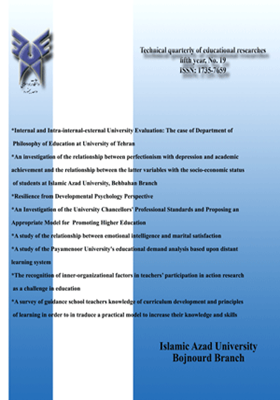A study of the Payamenoor University's educational demand analysis based upon distant learning system
Subject Areas : Educational Sciencemehran farajallahi 1 , mohammadreza sarmadi 2 , S.H Nemati 3
1 - استادیار، عضو هیات علمی دانشگاه پیام نور تهران .
2 - استادیار، عضو هیات علمی دانشگاه پیام نور تهران.
3 - عضو هیات علمی دانشگاه پیام نور مشهد
Keywords:
Abstract :
With characteristics such as flexible teaching and learning techniques, the safeguarding of education in even the most distant areas and guaranteeing equal educational opportunities specially for people with special requirements ( Homemakers, physically impaired, … ) the distant learning system paints a bright picture of the availability of education to all in the future. Iran Payamenoor University currently catering for approximately one million students, is the only existing university in Iran active in offering distant learning opportunities at associate, bachelor, masters and PhD levels in 400 educational centers and units. As Payamenoor University has been active in education and research, an investigation of how the aim of this educational system "anyone, anywhere, anytime can again access to higher education" has been accomplished in its educational centers and units is essential. A research entitled "a study of the Payamenoor University's educational demand evaluation based upon distant learning system" was conducted over a two year period. A descriptive-evaluative technique was employed and the statistic population included University lecturers, students and administrators of Payamenoor University educational centers and units (70 in total) in the country's 30 provinces. Applying a classified-random sampling system and utilizing Cockrun's Formula, 3000 students, 300 members of the university faculty and 30 administrators were selected as the statistical sample. Three surveys were prepared using an evaluative-documentative method (A survey directed at students, one directed at lecturers and a third directed at the administrators). The reliability of these surveys was estimated using the Gronbach Alpha and was found to be 82% for students, 80% for lecturers, and 78% for administrators. The data was then prepared for analysis using Microsoft Excel and analyzed


